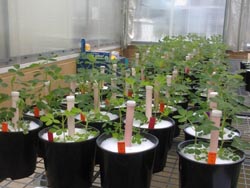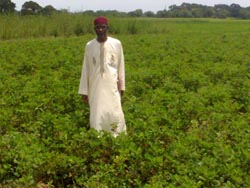Aliyu Anchau, Abdullahi enrolled for his PhD studies in February, 2013 on the above topic. Arachis hypogaea L. root nodules were initially sampled from uninoculated plants in over ninety (90) farmers’ fields from the Northern Guinea and Sudan savannas of Nigeria during the 2013/2014 growing season. Thirty two (32) rhizobia strains were successfully isolated from the root nodules, authenticated and tested for effectiveness in glasshouse experiments under axenic N-free conditions. The treatments include uninoculated controls without inorganic nitrogen applied, positive N controls (10 g L-1 N applied as KNO3), Bradyrhizobium sp. strain NC 92 as industry standard reference strain and the newly isolated strains. Top dry matter yields and N concentrations in tops were determined. The percentage dry matter yield and N accumulation of each strain were calculated relative to the positive N control.
 |
These results indicated that the strains had varying effectiveness, with some strains performing similar to NC 92 and some higher than both NC 92 and the positive N control (Figure 1: Percent dry weight accumulated by SAMNUT 24 groundnut genotype with the newly isolated Nigerian indigenous rhizobia strains in relation to the positive N control (10 g L-1 N applied as KNO3) |
Positive responses of groundnut genotypes SAMNUT 22 and SAMNUT 24 were observed in field experiments, testing some of the strains in the Northern Guinea and Sudan savannas of Nigeria during the 2014/2015 growing season.
 |
Glasshouse experiment, testing some of the newly isolated Nigerian strains of rhizobia, along with NC 92, +N (10 g L-1 KNO3) and –N (Uninoculated control) on SAMNUT 22 and SAMNUT 24 groundnut genotypes at 5 weeks after sowing |
| Field experiment, testing some of the newly isolated indigenous Nigerian rhizobia strains (SBG 234, SNN 343 and KBU 26) on SAMNUT 24 and SAMNUT 22 groundnut genotypes at the Experimental farm of the Institute for Agricultural Research (IAR), Ahmadu Bello University, Samaru, Zaria, Nigeria during the 2014/2015 growing season: (left) 02/08/2014 at 4 weeks after sowing (right) 30/9/2014 at 12 weeks after sowing |  |
 |
Two best performing strains from the field experiment along with other two promising strains are now being tested under similar field conditions during the 2015/2016 growing season for confirmation of the results. Morphological characteristics and RPO1 fingerprints indicate genetic diversity among the strains. Further molecular characterization, N calibration and root nodule morphology studies of the strains are in progress. Careful selection from these indigenous strains could fill the vacancy of effective local inoculant strains for groundnut in Nigeria and similar environments. The studies shall hopefully be concluded in February, 2016.
Aliyu Anchau, Murdoch University, Australia
